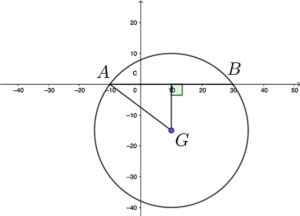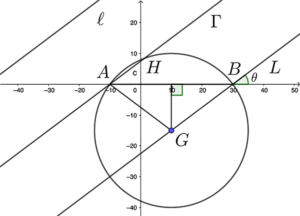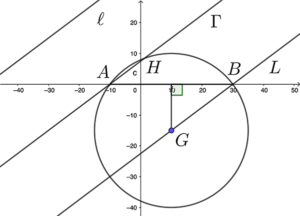- Since $AB$ is a horizontal chord of the circle $C$, then the $x$ coordinate of the mid-point of $AB$ is equal to that of the centre $G$.

The $x$-coordinate of $G$
$\begin{array}{cl}
= & \dfrac{30 + (-10)}{2} \\
= & 10
\end{array}$Therefore, the equation of $C$ is
$\begin{array}{rcl}
(x – 10)^2 + (y – (-15))^2 & = & (\sqrt{(30 – 10)^2 + (0 – (-15)^2})^2 \\
(x – 10)^2 + (y + 15)^2 & = & 625
\end{array}$ -
- $\Gamma$ is parallel to $L$.
- Since $\Gamma$ is parallel to $L$, then we have
$\begin{array}{rcl}
m_\Gamma & = & m_L \\
m_\Gamma & = & \dfrac{0 – (-15)}{30 – 10} \\
m_\Gamma & = & \dfrac{3}{4}
\end{array}$Therefore, the equation of $\Gamma$ is
$\begin{array}{rcl}
\dfrac{y – 0}{x – (-10)} & = & \dfrac{3}{4} \\
4y & = & 3(x + 10) \\
3x – 4y + 30 & = & 0
\end{array}$ -

Note that $\angle GAH = \angle GAB + \angle BAH$. Consider $\angle BAH$.
$\begin{array}{rcl}
\tan \angle BAH & = & m_\Gamma \\
\tan \angle BAH & = & \dfrac{3}{4} \\
\angle BAH & = & 36.869\ 897\ 65^\circ
\end{array}$Consider $\angle BAG$. In $\Delta GAB$,
$\begin{array}{rcll}
GA & = & GB & \text{(radii)} \\
\angle BAG & = & \angle ABG & \text{(base $\angle$s, isos. $\Delta$)} \\
\angle ABG & = & \theta & \text{(vert. opp. $\angle$s)} \\
\therefore \angle BAG & = & \theta
\end{array}$Also,
$\begin{array}{rcl}
\tan \theta & = & m_L \\
\tan \angle BAG & = & \dfrac{3}{4} \\
\angle BAG & = & 36.869\ 897\ 65^\circ
\end{array}$Hence, we have
$\begin{array}{rcl}
\angle GAH & = & \angle GAB + \angle BAH \\
& = & 36.869\ 897\ 65^\circ + 36.869\ 897\ 65^\circ \\
& = & 73.739\ 795\ 29^\circ \\
& > & 70^\circ
\end{array}$Therefore, I don’t agree with the claim.

2020-I-14
Ans: (a) $(x-10)^2 + (y + 15)^2 = 625$ (b) (i) $\Gamma$ is parallel to $L$. (ii) $3x – 4y +30 = 0$ (iii) No

